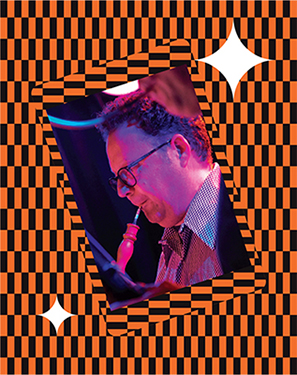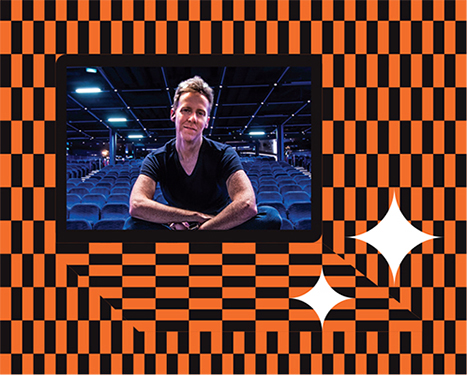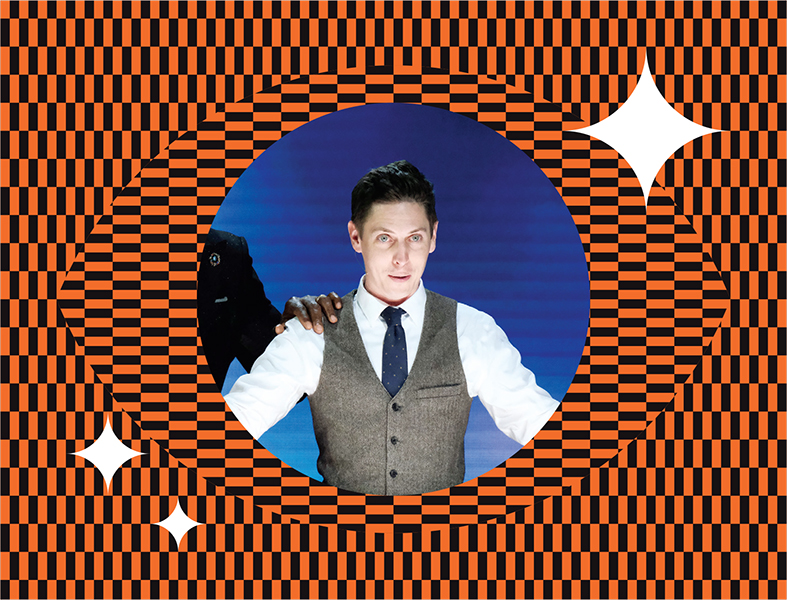This article is drawn from the third issue of Tafel: our magazine for the musically curious. Offered three times a year, this publication will, we hope, welcome new friends as well as extend the rich conversations we are already having with so many of you. Read the entire third issue here.
Grand Illusion
By Luisa Trisi
What do music and magic have in common? There’s more to it than meets the eye.
As a young boy growing up in the Italian village of Malo, Vicenza, Tafelmusik oboist and visual artist Marco Cera was mesmerized by the local auto mechanic, whose side hustle as a magician made him a popular fixture around town. Cera recalls seeing him at the café entertaining the locals with card tricks, and at parties performing the classic illusion of sawing a woman in half.
A few decades later, Cera’s childhood fascination with the world of illusion has come full circle. Together with Nick Wallace, an award-winning practitioner of the art of astonishment, and Music Director Elisa Citterio, Cera is creating a new digital program about music and magic for Tafelmusik’s 2021/22 digital season. Combining Wallace’s magic vignettes with music by baroque composers performed by Tafelmusik, the film explores the parallels between these two entrancing art forms.
The timing of Cera’s program is no coincidence. One of the more intriguing trends to emerge from the pandemic is the huge popularity of online magic shows, which have attracted new audiences “in a way not seen since the ‘Golden Age of Magic’ in the 1920s, when stars like Dante, Thurston, Carter the Great, Dai Vernon and most of all, Harry Houdini, were household names” (Forbes).
Marco Cera. Photo by Russel Druiven | Ryan Joyce
After many months of being cooped up and isolated, are we simply longing for enchantment and an escape from the anxiety of endless lockdowns and vaccine supply shortages? Or has the pandemic profoundly shaken confidence in our fundamental assumptions about how daily life is supposed to unfold? For Wallace, “a magic show is a safe place to play with those assumptions. It’s a tacit agreement that an audience and a magician make: you know this isn’t real, and I know this isn’t real, but let’s just play for the next 30 minutes — unlike in the real world, where it’s not a good feeling to have your assumptions rocked.”
Veteran magician and digital media producer Ryan Joyce has joined the film’s creative team as director. As a successful content producer, Joyce believes that magic is an art form that still retains its impact when conveyed digitally. “Magic can make you have a startling moment that is above your normal threshold of emotions. So you can really feel a sense of wonder through the camera. Magic makes viewers ask ‘What just happened there?’ Those are the questions that linger in people’s minds and that stick with them just a little bit longer. Because it questions the things that they thought were true.”
“The soul should always stand ajar.” —Emily Dickinson
As one live performance after another was cancelled in March 2020, Wallace was initially skeptical about taking his shows online. “I was so hesitant because I thought, people are just really hungry for entertainment. Well now you’re competing with Netflix, Game of Thrones, Steven Spielberg. I wondered, why wouldn’t people just watch YouTube if they wanted to see magic? But it’s the fact that magic breaks that fourth wall, even if you’re doing it digitally.”
Cera first made the connection between music and magic while doing research for his 2018 Tafelmusik multimedia program, The Harlequin Salon. He came across the 17th-century English conjurer and entrepreneur Isaac Fawkes, a contemporary of Handel. Fawkes widely promoted his “Tricks by Dexterity of Hand, with Cards, Eggs, Corn, Mice, curious India Birds, and Money” and became the first magician to shift his act from the streets of London to the stage. In fact, he performed before King George II at the Haymarket Theatre — the same venue where Handel presented his operas for royalty and the public alike.
Cera points to several parallels between the two art forms, including the manual dexterity required to master both musical instruments and sleight of hand, the discipline that is fundamental to the art of creating illusions; the inherent perfectionism and many hours of practising required to make the most difficult sequences appear effortless; and the ability to create authentic moments of awe and wonder that arouse the senses.
“I was raised in a home that was filled with music and have always had a deep reverence for its power to lift us into another dimension,” says Music Director Elisa Citterio. “Marco and Nick have created something very special with this project, and I am delighted that we will be able to share it with our audience.”
When he was growing up, magic was a secret refuge for Wallace, who also played violin for almost 15 years. “I got hooked on magic when I was young. I was never terribly good at the violin because when I was supposed to be practising music, I was secretly practising magic. And that’s what won out. So in some ways, this show feels like it’s been a long time coming. It feels like I’ve finally come full circle.”
Like the appeal of magic shows during the current pandemic, illusionism in baroque art and architecture was, in part, a reaction to uncertainty and upheaval. “Artistic devices of spatial illusion were developed in Europe during the 17th century in response to cultural anxieties occasioned by revolutionary scientific discoveries, revolutionary religious upheaval, and also by the new taste for virtuosic visual display,” wrote the renowned American art historian Lois Parkinson Zamora in a publication for the University of Houston. “The authority of perception was being undermined, and baroque artists responded accordingly — and often fantastically — with structures intended to deceive the eye — the literal meaning, of course, of trompe l’oeil.”
Nick Wallace
In the same way that modern illusionists manipulate our senses, baroque architects experimented with curves, light, and proportions to create clever optical illusions. Sculptors like Gian Lorenzo Bernini perfectly rendered the human form in solid marble — deceptively appearing as soft and malleable as flesh, drapery, or fine cloth. Painters like Rembrandt, Vermeer, and Caravaggio relied on chiaroscuro, foreshortening, and other optical techniques that brought illusionism to new heights during the 17th century. Cera notes that baroque composers, including Bach and Telemann, created auditory illusions, such as the phenomenon of melodic fission, where a single melody is perceived as two melodic lines.
As we navigate the ever-shifting sands of 2021, many of us are looking for a sprinkling of enchantment within the narrow confines of our daily routines. Is it possible for magic to manifest itself in our world today? Joyce suggests that the potential lies within each of us. “Belief is a really powerful vehicle for change, and I’m a firm believer in preaching the metaphor of magic: If you believe in something impossible, and you take action by making the effort and doing the work, it can have magical effects. We can choose to see magic all around us; those moments are everywhere.”
Luisa Trisi is the founder of Big Picture Communications, a Toronto-based company specializing in strategic communications.




